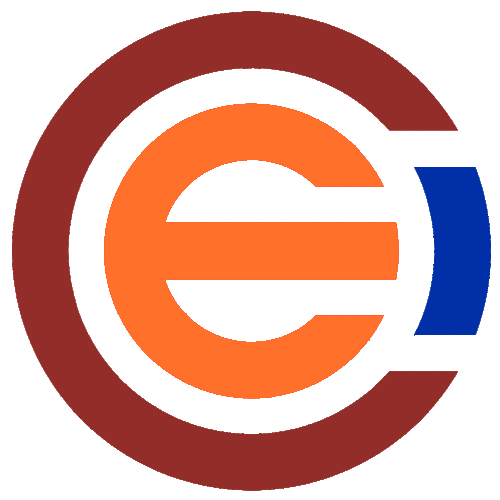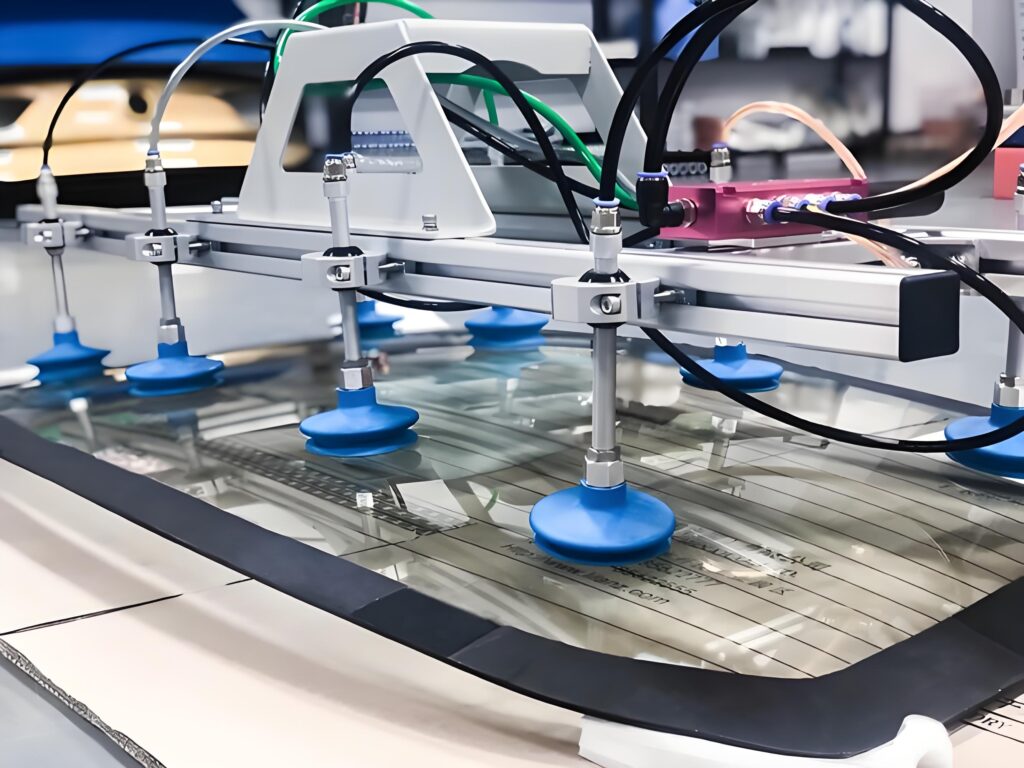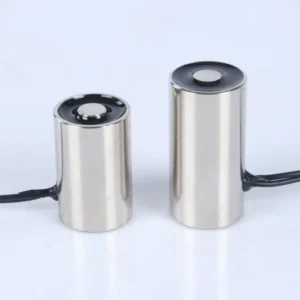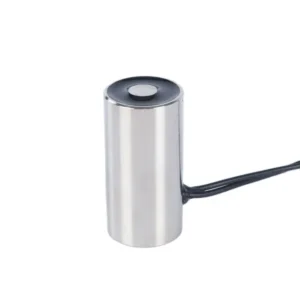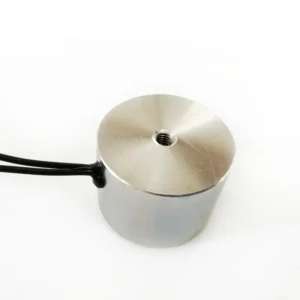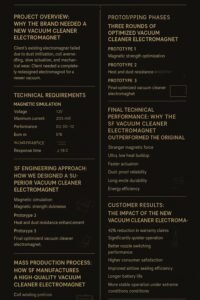Last Updated on 2025-09-04 by SolenoidFactory
Robotic arms have revolutionized industries ranging from automotive manufacturing to electronics assembly. These mechanical marvels perform tasks with unparalleled speed, precision, and repeatability, making them indispensable in modern production lines. A critical component of their functionality lies in their end-effectors—the devices responsible for gripping, lifting, and positioning objects. While traditional grippers rely on mechanical clamps, suction cups, or pneumatic systems, electromagnets are emerging as a game-changing solution for specific applications.
As a professional electromagnet manufacturer, we delve into the science, advantages, and real-world applications of electromagnets in robotic gripping and positioning. This blog explores how electromagnets enhance automation, their technical nuances, and their potential to redefine industrial processes.
1. The Science Behind Electromagnetic Gripping
1.1 How Electromagnets Work
Electromagnets generate a magnetic field when an electric current passes through a coil of wire. This field can be turned on or off instantaneously, allowing precise control over magnetic force. The core material (often iron or steel) amplifies the magnetic flux, creating a strong attraction force when energized. When the current stops, the magnetic field collapses, releasing the object.
1.2 Key Components of Electromagnetic Grippers
- Coil: The wire wound around a core, which generates the magnetic field when energized.
- Core: A ferromagnetic material that concentrates and directs the magnetic flux.
- Power Supply: Provides the necessary current to activate the electromagnet.
- Control System: Regulates the current to adjust gripping force and timing.
1.3 Types of Electromagnetic Grippers
- Flat-Faced Electromagnets: Ideal for gripping flat or smooth surfaces.
- Custom-Profile Electromagnets: Designed to match the shape of specific objects (e.g., cylindrical or irregular parts).
- Electro-Permanent Magnets (EPMs): Combine permanent magnets and electromagnets to maintain a grip without continuous power.
2. Advantages of Electromagnetic Gripping in Robotic Arms
2.1 Non-Contact Gripping
Unlike mechanical clamps that require physical contact, electromagnets can grip objects without touching them. This is particularly beneficial for handling delicate or sensitive materials, such as glass panels, polished metal surfaces, or semiconductor wafers, where scratches or contamination must be avoided.
2.2 Adjustable Gripping Force
By modulating the electric current, the magnetic force can be fine-tuned to suit different object weights and sizes. This flexibility reduces the risk of damaging fragile items while ensuring a secure grip on heavier loads.
2.3 High Speed and Precision
Electromagnets activate and deactivate in milliseconds, enabling rapid pick-and-place operations. Their precise control also allows robotic arms to position objects with micron-level accuracy, critical for applications like microelectronics assembly.
2.4 Energy Efficiency
Electro-permanent magnet (EPM) systems consume power only during the switching phase (on/off), making them highly energy-efficient compared to pneumatic or hydraulic systems that require constant energy input.
2.5 Durability in Harsh Environments
Electromagnetic grippers are resistant to dust, moisture, and temperature fluctuations, making them suitable for challenging environments like foundries, food processing plants, or outdoor logistics.
3. Applications of Electromagnetic Grippers in Industry
3.1 Automotive Manufacturing
In car assembly lines, robotic arms equipped with electromagnets handle metal sheets, engine components, and body panels. The grippers’ rapid response and precise control streamline processes like welding, painting, and part sorting.
Case Study: A leading automotive manufacturer reduced cycle times by 20% by replacing pneumatic grippers with electromagnets for handling stamped metal parts.
3.2 Electronics and Semiconductor Production
Electromagnetic grippers are ideal for manipulating silicon wafers, circuit boards, and microchips. Their non-contact operation prevents electrostatic discharge (ESD) damage, while their precision ensures alignment during soldering or packaging.
3.3 Logistics and Warehousing
In automated warehouses, robotic arms with electromagnetic grippers sort, stack, and retrieve metal containers, pallets, or machinery parts. Their ability to handle heavy loads (up to 1,000+ kg) improves efficiency in material handling.
Example: An e-commerce giant deployed electromagnetic grippers in its fulfillment centers to handle irregularly shaped metal bins, achieving a 30% increase in sorting speed.
3.4 Metalworking and Forging
Electromagnets excel in handling hot or oily metal parts in forging presses, CNC machines, or stamping lines. Their rugged design withstands high temperatures and mechanical stress.
3.5 Recycling and Waste Management
Robotic arms with electromagnetic grippers separate ferrous metals from waste streams. Their selectivity and speed enhance recycling efficiency while reducing manual labor.
-
Rated 0 out of 5
-
Rated 0 out of 5
-
Rated 0 out of 5
-
Rated 0 out of 5
4. Technical Challenges and Solutions of electromagnets
4.1 Material Limitations
Challenge: Electromagnets only attract ferromagnetic materials (e.g., iron, steel, nickel).
Solution: Hybrid systems combining electromagnets with suction cups or mechanical grippers can handle non-magnetic materials.
4.2 Heat Dissipation
Challenge: Prolonged use generates heat in the coil, reducing efficiency.
Solution: Advanced cooling systems, such as liquid-cooled coils or heat-resistant materials, maintain performance.
4.3 Power Supply Stability
Challenge: Inconsistent voltage can affect gripping force.
Solution: Precision power supplies with feedback control ensure stable current delivery.
4.4 Safety and Redundancy
Challenge: Power failures could lead to accidental drops.
Solution: Electro-permanent magnets (EPMs) retain their grip without power, while backup batteries or fail-safe circuits provide additional security.
5. Innovations Shaping the Future of electromagnets
5.1 Smart Electromagnets with IoT Integration
Modern electromagnetic grippers are equipped with sensors to monitor parameters like temperature, current, and grip strength. Data is transmitted to centralized systems for predictive maintenance and process optimization.
Example: A smart gripper detects wear in the coil insulation and alerts operators before a failure occurs.
5.2 AI-Driven Adaptive Gripping
Machine learning algorithms analyze object shapes and weights to adjust gripping force dynamically. This is particularly useful for handling mixed batches of parts in flexible manufacturing systems.
5.3 Lightweight and Modular Designs
Advances in materials (e.g., high-strength alloys, composites) enable compact, lightweight electromagnets that reduce the payload on robotic arms. Modular designs allow quick customization for different tasks.
5.4 Energy Harvesting Systems
Emerging technologies capture residual energy during gripper deactivation, feeding it back into the power supply to improve overall efficiency.
5.5 Collaborative Robotics (Cobots)
Electromagnetic grippers are being integrated into cobots that work alongside humans. Safety features like force-limiting controls ensure safe interactions.
6. Choosing the Right Electromagnets Gripper
6.1 Key Considerations
- Object Characteristics: Material, weight, shape, and surface finish.
- Operating Environment: Temperature, humidity, and exposure to contaminants.
- Cycle Time: Required speed for pick-and-place operations.
- Power Requirements: Voltage, current, and energy efficiency.
6.2 Customization Options
As a professional manufacturer, we offer tailored solutions, including:
- Custom Core Shapes: Designed to match unique part geometries.
- Multi-Coil Systems: For handling multiple objects simultaneously.
- Integrated Control Systems: Seamless integration with PLCs or robotic controllers.
Electromagnets—The Future of Robotic Precision
Electromagnetic grippers represent a paradigm shift in robotic automation, offering unmatched speed, precision, and versatility. From handling delicate electronics to lifting heavy industrial parts, their applications are vast and transformative. As industries continue to embrace Industry 4.0, the demand for intelligent, energy-efficient, and adaptive gripping solutions will only grow.
For businesses seeking to optimize their automation workflows, electromagnets provide a compelling alternative to traditional gripping systems. By partnering with an experienced electromagnet manufacturer, companies can unlock new levels of efficiency, reduce operational costs, and stay ahead in the competitive landscape of modern manufacturing.
About SF electromagnets factory
Shengfeng Electromagnet Co., Ltd. was established in 2015 and is located in the Xiansha Industrial Park with beautiful scenery and convenient transportation. The company covers an area of 16000 square meters and has modern production plants, advanced production equipment and a high-quality technical team. Since its establishment, we have always adhered to the corporate philosophy of “innovation, quality, and service”, focusing on the research and development and production of electromagnets, constantly promoting product upgrades and technological progress, and providing customers with the best quality products and services.
Why choose SF electromagnet
HIGH END QUALITY:As the best solenoid electromagnet manufacturer in china, our QC team will ensure every single product you receive are best quality. We have professional quality testing machine.
PRODUCT DESIGN:Our sampling department has complete process of making drawings into reality. We also improve your product design based on our years of working experience.Tell us what you think.
STABLE DELIVERY TIME:As the best electromagnet manufacturer & supplier,we have sufficient manufacturing capacity, big orders won’t beat us, we can still deliver the order for you in time.
BEST PRICE:We are source factory of electromagnet and the best solenoid manufacturer in China, that’s why we can provide high quality bags with best price.
PRECISE MANAGEMENT:Nothing can be achieved if we don’t implement precise management. We are a company with complete management system.
7-24 SERVICE:As the best solenoid manufacturer, 24-7 immediate response: We’ll receive your feedback to make us a better supplier. Contact WhatsApp +86 18902611680
FAQs of electromagnet
We are a Chinese top electromagnet manufacturer and our factory is located in Dongguan. Welcome to visit our factory!
We pecialize in the design and production of high quality electromagnet,solenoid valve,such as rotary solenoid, bistable solenoids, latching solenoids, open frame solenoids, tubular solenoids, self-holding solenoid
•Of course, usually we will provide free samples, and you only need to cover the freight. For custom electromagnet samples, pls send your requirements to us for checking the sample cost.
• It takes about 7 days for sample production.
Yes, we provide free design services, structural design and simple graphic design.
Sure. We can do any electromagnet with your design. Now we open a ODM solenoid which is for small quantity from 100pc to 500pc,but you can still have your own logo.
Depending on the order quantity and production details, it will take about 15 to 20 days.
Always a pre-production sample before mass production; Always final Inspection before shipment
• Power,usage,size, material, quantity, shipping destination, etc.
• You can also just tell us your requirements and we will recommend products to you.
• By sea, by air or by express.
• If you have your own freight forwarder in China, it is the ex-factory or FOB price.
•CFR or CIF, etc., if you need us to ship on your behalf.
• DDP and DDU can also be used.
• More choices, we will consider your choices.
• The price is determined by the quantity, material, processing method, size and other factors. In addition, due to our continuous
technological innovation, the prices of some of our products are extremely competitive, please contact us to quote.
